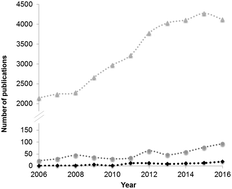当前位置:
X-MOL 学术
›
Food Funct.
›
论文详情
Our official English website, www.x-mol.net, welcomes your feedback! (Note: you will need to create a separate account there.)
Edible oleogels: an opportunity for fat replacement in foods
Food & Function ( IF 6.1 ) Pub Date : 2018-01-12 00:00:00 , DOI: 10.1039/c7fo01641g Artur J. Martins 1, 2, 3, 4 , António A. Vicente 1, 2, 3, 4 , Rosiane L. Cunha 5, 6, 7, 8, 9 , Miguel A. Cerqueira 4, 10, 11
Food & Function ( IF 6.1 ) Pub Date : 2018-01-12 00:00:00 , DOI: 10.1039/c7fo01641g Artur J. Martins 1, 2, 3, 4 , António A. Vicente 1, 2, 3, 4 , Rosiane L. Cunha 5, 6, 7, 8, 9 , Miguel A. Cerqueira 4, 10, 11
Affiliation

|
The scientific and industrial communities have been giving great attention to the development of new bio-based materials with potential use in innovative technological applications. Among these materials are the structures with gel-like behavior that can be used in the cosmetic, pharmaceutical and food industries, aiming at controlling the physical properties of the final products. In the past ten years, words like oleogels and organogels have been increasingly used, the existing number of manuscripts and patents being proof of this tendency. In the food industry, oleogels can be used to control phase separation, and decrease the mobility and migration of the oil phase, providing solid-like properties without using high levels of saturated fatty acids as well as to be a carrier of bioactive compounds. In most cases, their main features are related to the reorganization process of gelators after an increase of the temperature, above the melting or glass transition temperature of the materials, known as the direct method, but it is also possible to develop oleogels by indirect methods, such as emulsification and the solvent exchange technique. In the direct methods, the reorganization is able to physically entrap oil leading to different physicochemical properties, the rheological behavior and texture properties being the frequently most studied ones. This review overviews the use of food grade and bio-based structurants to produce edible oleogels, aiming at fat replacement and structure-tailoring. Gelation mechanisms and oil phases used during oleogel production are discussed, as well as the current food applications and future trends for this kind of structure.
中文翻译:

食用油:食物中脂肪替代的机会
科学界和工业界一直非常重视新的生物基材料的开发,这些材料有可能在创新技术应用中使用。在这些材料中,具有凝胶状行为的结构可用于化妆品,制药和食品工业,旨在控制最终产品的物理性能。在过去的十年中,越来越多地使用诸如油凝胶和有机凝胶之类的词,现有的手稿和专利数量证明了这种趋势。在食品工业中,油分子可用于控制相分离,降低油相的迁移率和迁移,提供固体状特性而无需使用高含量的饱和脂肪酸以及作为生物活性化合物的载体。在多数情况下,它们的主要特征与温度升高后,高于材料的熔融或玻璃化转变温度后的胶凝剂的重组过程有关,称为直接法,但也可以通过间接法(例如乳化法)制得油凝胶和溶剂交换技术。在直接方法中,重组能够物理地截留油,从而导致不同的理化性质,流变行为和质地性质是最经常研究的。这篇综述概述了食品级和生物基结构化剂在生产食用油中的用途,旨在脂肪替代和结构定制。讨论了油凝胶生产过程中使用的胶凝机理和油相,
更新日期:2018-01-12
中文翻译:

食用油:食物中脂肪替代的机会
科学界和工业界一直非常重视新的生物基材料的开发,这些材料有可能在创新技术应用中使用。在这些材料中,具有凝胶状行为的结构可用于化妆品,制药和食品工业,旨在控制最终产品的物理性能。在过去的十年中,越来越多地使用诸如油凝胶和有机凝胶之类的词,现有的手稿和专利数量证明了这种趋势。在食品工业中,油分子可用于控制相分离,降低油相的迁移率和迁移,提供固体状特性而无需使用高含量的饱和脂肪酸以及作为生物活性化合物的载体。在多数情况下,它们的主要特征与温度升高后,高于材料的熔融或玻璃化转变温度后的胶凝剂的重组过程有关,称为直接法,但也可以通过间接法(例如乳化法)制得油凝胶和溶剂交换技术。在直接方法中,重组能够物理地截留油,从而导致不同的理化性质,流变行为和质地性质是最经常研究的。这篇综述概述了食品级和生物基结构化剂在生产食用油中的用途,旨在脂肪替代和结构定制。讨论了油凝胶生产过程中使用的胶凝机理和油相,


























 京公网安备 11010802027423号
京公网安备 11010802027423号